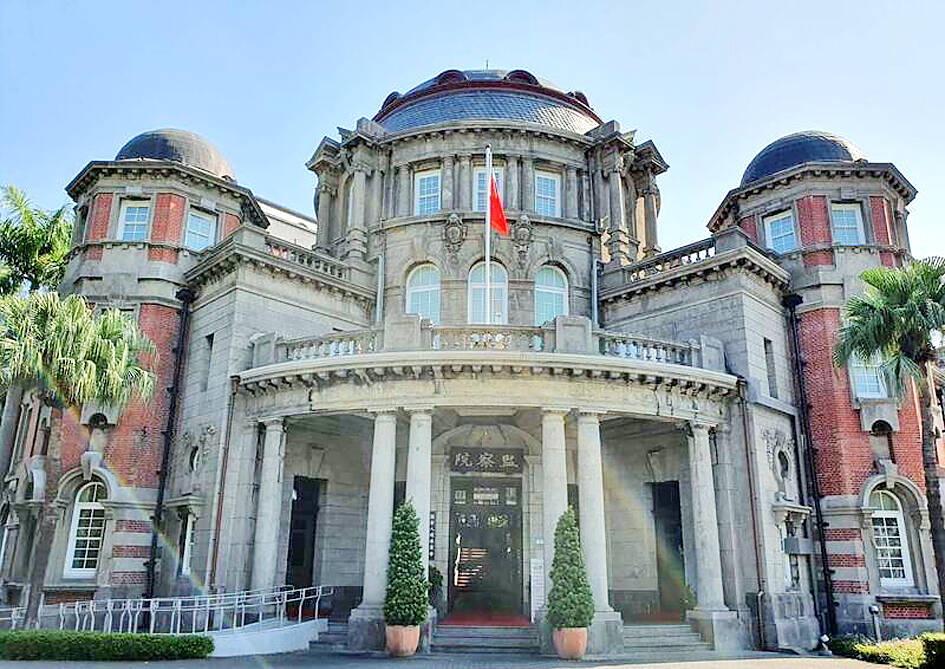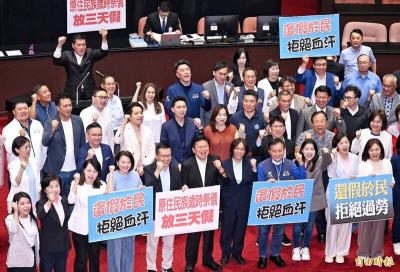The Control Yuan has censured the Ministry of Culture following a probe into claims that installations of public art have been monopolized by a few agents.
The Control Yuan’s Committee on Educational and Cultural Affairs on Jan. 11 passed an investigative report submitted by Control Yuan members Fan Sun-lu (范巽綠), Su Li-chung (蘇麗瓊) and Lin Sheng-fong (林盛豐) and forwarded the report to government agencies for review, the Control Yuan said in a press release yesterday.
The government has been

Photo: Hsieh Chun-lin, Taipei Times
promoting public art installations for 25 years, spending about NT$9.93 billion (US$316.73 million) to complete 5,126 works in 2,455 projects as of 2021, it said.
However, the installations drew extensive criticism, including that they ended up as garbage, destroyed the beauty of the environment, wasted money and were monopolized by a few agents, it said.
The Regulations on the Installation of Public Art (公共藝術設置辦法) are becoming more complicated and many of the administrative agents involved in public art installation projects lacked expertise in the field, the members said.
From 2011 to 2021, 711 out of 1,517 projects — 47.4 percent — were handled by agents,using about 68.28 percent of all funding, statistics provided by the ministry showed, it said.
In 2021 alone, 84 out of 141 projects were handled by agents, with four agents handling 58 projects, 41 percent, it said.
Some agents had unusual connections with the company that won the bid for the project, but the ministry failed to look into the situation, it added.
There are only 366 members in the ministry’s database of experts and academics, unevenly distributed across expertise, and no new additions were made for years, it said.
Some members are heads of agencies so they would be personally involved in a project while reviewing other projects at the same time, it said.
The promotion of public art had seen some success at first, including the project along Taipei’s Dunhua S Road and Dunhua N Road
and the Dome of Light at the Formosa Boulevard Station in
Kaohsiung, it said.
The ministry failed to adhere to its objective and move with the times to nurture young artists, respond to environmental challenges with innovative solutions or demonstrate sustainable values, which resulted in a lack of public artworks with Taiwanese characteristics, it said.
The Ministry of National Defense even allowed its agencies to import unfinished products from China, it said, citing examples that were found in the Amis Longshan (龍山) Camp, Yuqin (育勤) Camp and Gueiren (歸仁) Camp, it said.
The Ministry of Culture should come up with solutions to these practices as they are not conducive to the development of public art, it said.
The Culture and Arts Reward and Promotion Act (文化藝術獎助及促進條例) requires public buildings and major construction projects to allocate no less than 1 percent of the total cost of the project for public art, which is a stipulation rarely seen in advanced countries, it said.
The Ministry of Culture should seek opinions from experts and refer to foreign practices while planning to amend the act to avoid prescribing unreasonably high budgets, it said.
The Control Yuan also suggested that the ministry establish dedicated and professional teams to provide professional guidance to public art installation projects to prevent any party from obtaining improper benefits.

The Ministry of Education (MOE) is to launch a new program to encourage international students to stay in Taiwan and explore job opportunities here after graduation, Deputy Minister of Education Yeh Ping-cheng (葉丙成) said on Friday. The government would provide full scholarships for international students to further their studies for two years in Taiwan, so those who want to pursue a master’s degree can consider applying for the program, he said. The fields included are science, technology, engineering, mathematics, semiconductors and finance, Yeh added. The program, called “Intense 2+2,” would also assist international students who completed the two years of further studies in

Former president Tsai Ing-wen (蔡英文) departed for Europe on Friday night, with planned stops in Lithuania and Denmark. Tsai arrived at Taiwan Taoyuan International Airport on Friday night, but did not speak to reporters before departing. Tsai wrote on social media later that the purpose of the trip was to reaffirm the commitment of Taiwanese to working with democratic allies to promote regional security and stability, upholding freedom and democracy, and defending their homeland. She also expressed hope that through joint efforts, Taiwan and Europe would continue to be partners building up economic resilience on the global stage. The former president was to first

Taiwan will now have four additional national holidays after the Legislative Yuan passed an amendment today, which also made Labor Day a national holiday for all sectors. The Chinese Nationalist Party (KMT) and Taiwan People’s Party (TPP) used their majority in the Legislative Yuan to pass the amendment to the Act on Implementing Memorial Days and State Holidays (紀念日及節日實施辦法), which the parties jointly proposed, in its third and final reading today. The legislature passed the bill to amend the act, which is currently enforced administratively, raising it to the legal level. The new legislation recognizes Confucius’ birthday on Sept. 28, the

MORE NEEDED: Recall drives against legislators in Miaoli’s two districts and Hsinchu’s second district were still a few thousand signatures short of the second-stage threshold Campaigners aiming to recall Chinese Nationalist Party (KMT) legislators yesterday said they expect success in 30 out of 35 districts where drives have passed the second-stage threshold, which would mark a record number of recall votes held at once. Hsinchu County recall campaigners yesterday announced that they reached the second-stage threshold in the recall effort against Legislator Lin Szu-ming (林思銘). A total of 26,414 signatures have been gathered over the past two months, surpassing the 10 percent threshold of 23,287 in Hsinchu County’s second electoral district, chief campaigner Hsieh Ting-ting (謝婷婷) said. “Our target is to gather an additional 1,500 signatures to reach